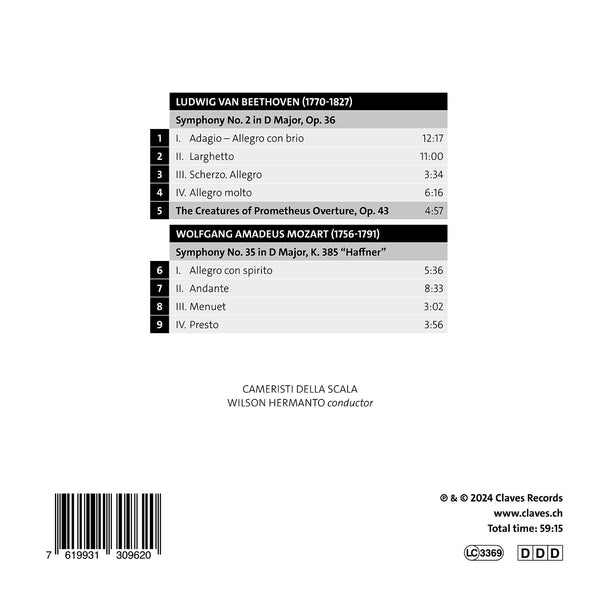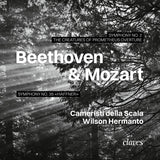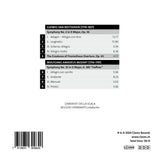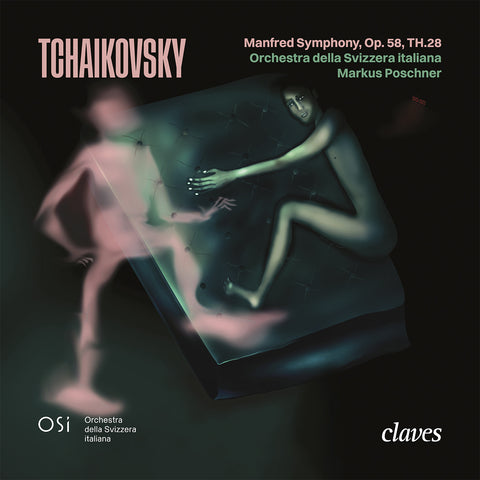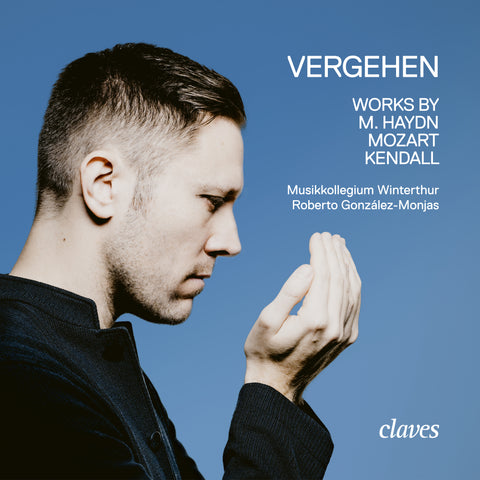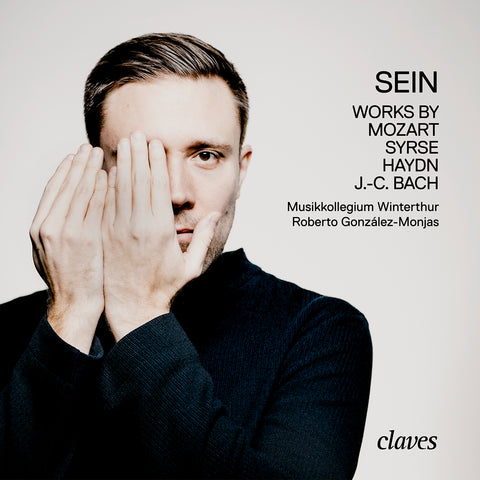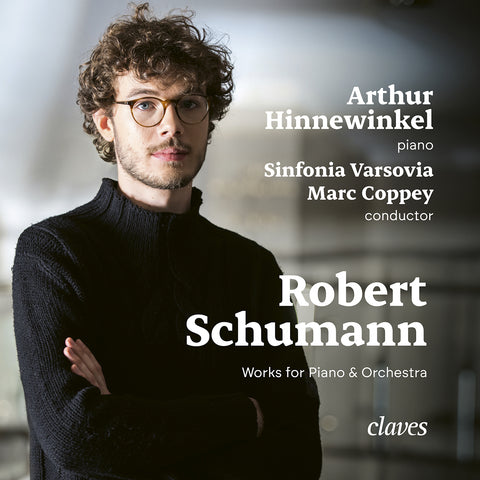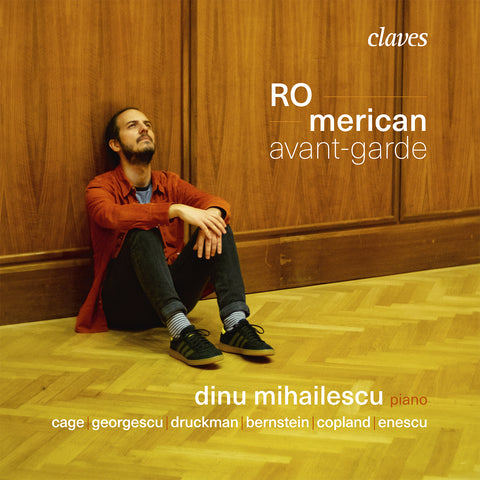(2024) Beethoven & Mozart - Cameristi della Scala, Wilson Hermanto
Kategorie(n): Orchester Repertoire
Hauptkomponist: Ludwig van Beethoven
Orchester: Cameristi della Scala
Dirigent: Wilson Hermanto
CD-Set: 1
Katalog Nr.:
CD 3096
Freigabe: 08.11.2024
EAN/UPC: 7619931309620
Dieses Album ist jetzt neu aufgelegt worden. Bestellen Sie es jetzt zum Sonderpreis vor.
CHF 18.50
Dieses Album ist nicht mehr auf CD erhältlich.
Dieses Album ist noch nicht veröffentlicht worden. Bestellen Sie es jetzt vor.
CHF 18.50
Dieses Album ist nicht mehr auf CD erhältlich.
CHF 18.50
Inklusive MwSt. für die Schweiz und die EU
Kostenloser Versand
Dieses Album ist nicht mehr auf CD erhältlich.
Inklusive MwSt. für die Schweiz und die EU
Kostenloser Versand
Dieses Album ist jetzt neu aufgelegt worden. Bestellen Sie es jetzt zum Sonderpreis vor.
CHF 18.50
Dieses Album ist nicht mehr auf CD erhältlich.
This album has not been released yet.
Pre-order it at a special price now.
CHF 18.50
Dieses Album ist nicht mehr auf CD erhältlich.
CHF 18.50
Dieses Album ist nicht mehr auf CD erhältlich.
SPOTIFY
(Verbinden Sie sich mit Ihrem Konto und aktualisieren die Seite, um das komplette Album zu hören)
BEETHOVEN & MOZART - CAMERISTI DELLA SCALA, WILSON HERMANTO
Über dieses Album
Sinfonie Nr. 2 in D-Dur, op. 36 (1802)
Ludwig van Beethoven (Bonn, 1770 – Vienna, 1827)
Es ist faszinierend, den allmählichen Prozess zu verfolgen, durch den der junge Beethoven seine persönliche Stimme als Komponist fand. Der sogenannte „heroische“ Stil, in dem viele den „Inbegriff“ Beethovens sehen, mag mit der Dritten Symphonie, der Eroica, entstanden sein. Aber dieser Stil entstand nicht über Nacht. Bereits
Schon bald nach dem ersten fortissimo D , mit dem das „Adagio molto“ der Symphonie beginnt, wird klar, dass wir keine gewöhnliche symphonische Einleitung hören. Die erste große Veränderung findet in der Orchestrierung statt: Die Eröffnungsmelodie wird den Holzbläsern anvertraut, während die Streicher schweigen. Dies ist der erste Hinweis darauf, dass die Bläser in dieser Symphonie viel mehr zu tun haben werden, als nur die Streicher zu verdoppeln und ein oder zwei Soli zu spielen, wie es in früheren Werken üblich war. Wenn die Holzbläsermelodie von den Streichern wiederholt
Es gibt noch weitere Neuerungen. Die Musik durchläuft eine Reihe von Modulationen zu entfernten Tonarten; die Streicher huschen in Passagen mit schnellen Zweiunddreißigstelnoten auf und ab, in die die Hörner einige starke Off-Beat-Akzente einstreuen. Man kann Mozarts „Prager“ Symphonie (in derselben Tonart D-Dur) als Vorbild erkennen, aber Beethoven packte eine weitaus größere Anzahl von Ereignissen in etwas mehr als zwei Minuten Musik. [Lesen Sie mehr in der Broschüre]
Ouvertüre zu Die Geschöpfe des Prometheus, Op. 43 (1801)
Ludwig van Beethoven
Mit dreißig Jahren hatte Beethoven in Wien, der kaiserlichen Hauptstadt, in der er seit seinem 22. Lebensjahr lebte, längst den Status einer Berühmtheit erreicht. Mit seinen kurz vor Beginn des 19. Jahrhunderts entstandenen Werken wie der „Pathétique“-Sonate, den ersten sechs Streichquartetten und der Ersten Symphonie hatte er sich einen einzigartigen Platz im Wiener Musikleben erobert, und sein Ruhm begann sich über die Grenzen der Stadt hinaus zu verbreiten.
Es war nur logisch, dass ein so bekannter junger Komponist einen Auftrag vom kaiserlichen Theater erhielt. Im Jahr 1800 wurde Beethoven gebeten, eine Ballettpartitur für eine von Salvatore Viganò (1769-1821), einem in Italien geborenen Tänzer und Choreografen mit europäischem Ruf, konzipierte höfische Unterhaltung zu schreiben. Viganò folgte dem Beispiel von Jean-George Noverre, der die kompliziertere, stilisierte Kunst früherer Ballettmeister durch die Einführung einiger einfacher, aber ausdrucksstarker pantomimischer Elemente vereinfacht hatte. Viganòs Ansatz war in Wien zunächst umstritten, wo der frühere Stil lange Zeit vorherrschte, doch sein natürlicher, ungekünstelter Stil eroberte allmählich die Herzen der Ballettliebhaber der Stadt. [Lesen Sie mehr im Booklet]
Symphony No. 35 („Haffner“) in D major, K. 385 (1782)
Wolfgang Amadeus Mozart (Salzburg, 1756 - Wien, 1791)
Die Mitglieder der Familie Haffner waren gute Freunde der Mozarts in Salzburg. Sigmund Haffner der Ältere (1699-1772) war ein wohlhabender Kaufmann und Bürgermeister der Stadt gewesen. In seinem Haus wurde viel Musik gespielt, und sowohl Vater Leopold als auch Sohn Wolfgang Mozart nahmen häufig daran teil. Die Beziehungen bestanden auch nach dem Tod des Bürgermeisters fort, und als seine Tochter Maria Elisabeth Haffner (1753-1784) 1776 heiraten sollte, wurde Mozart gebeten, eine festliche Musik für die Hochzeit zu schreiben. Die daraus resultierende „Haffner“-Serenade (KV 250) war so erfolgreich, dass der Komponist sechs Jahre später, als ein weiterer Grund zum Feiern anstand, einen neuen Auftrag von der Familie erhielt. Diesmal war der Anlass die Erhebung von Sigmund Haffner dem Jüngeren (1756-1787) in den Adelsstand.
In der Zwischenzeit hatte Mozart seine Heimatstadt verlassen und war nach Wien gezogen, wo sein Ruhm rasch wuchs. Als ihn im Juli 1782 die Anfrage aus Salzburg erreichte, war seine Oper Die Entführung aus dem Serail gerade erst uraufgeführt worden und er war damit beschäftigt, eine Auswahl daraus für ein Bläserensemble zu arrangieren. Außerdem stand seine Hochzeit mit Constanze Weber kurz bevor und er bereitete sich auf den Umzug in ein neues Quartier vor. Unter diesen Umständen ging die Komposition der neuen Symphonie langsamer voran, als es sich Vater Leopold, der darauf bedacht war, dass die Symphonie rechtzeitig zu den Feierlichkeiten eintraf, gewünscht hätte. Dennoch gelang es Mozart, die Partitur rechtzeitig zu versenden. Am 24. August konnte er seinem Vater schreiben: „Ich freue mich, dass die Symphonie Ihrem Geschmack entspricht.“ [Lesen Sie mehr im Booklet]
Cameristi della Scala
Das Kammerorchester „Cameristi della Scala“, das sich aus Musikern des Orchesters des Teatro alla Scala di Milano zusammensetzt, wurde 1982 gegründet. Das Markenzeichen dieses Kammerorchesters ist es, mit oder ohne Dirigent aufzutreten. Das Kernrepertoire umfasst viele Meisterwerke vom 18. Jahrhundert bis zur Gegenwart sowie die leidenschaftliche Förderung und Verteidigung der Werke weniger bekannter Komponisten. Die Cameristi della Scala treten regelmäßig mit weltberühmten Musikern wie Maxim Vengerov, Gautier Capuçon, Renaud Capuçon, Francesco Piemontesi, Alexandre Kantorow, Khatia Buniatishvili, Jan Lisiecki, David Fr ay, Till Fellner, Daniel Müller-Schott, Sergei Babayan, Alexei Volodin, Daniel Lozakovich, Giovanni Sollima und Nils Mönkemeyer auf und tritt mit den Solisten des Orchesters der Mailänder Scala auf. Viele berühmte Dirigenten, die in der Vergangenheit bis heute am Teatro alla Scala dirigiert haben, haben den Charakter und Klang der Cameristi della Scala, die für ihren unverwechselbaren italienischen Klang und ihre musikalische Phrasierung bekannt sind, maßgeblich beeinflusst.
Die Cameristi della Scala sind in vielen renommierten Veranstaltungsorten, Konzerthallen und bei Musikfestivals auf der ganzen Welt aufgetreten, darunter in der Carnegie Hall in New York, der Library of Congress in Washington D.C., der Salle Gaveau in Paris, der Tschaikowski-Halle in Moskau, der Tonhalle in Zürich, dem Mann Auditorium in Tel Aviv, Victoria Hall in Genf, Teatro Coliseo in Buenos Aires, Narodowa Opera Theatre in Warschau, George Enescu Festival in Bukarest, Vevey Spring Classic Festival in der Schweiz, Tbilisi Autumn Festival in Georgien, Izmir International Festival in der Türkei und viele andere. Bei einem ihrer jährlichen Konzerte im Teatro alla Scala spielte das Orchester 2018 ein Programm zu Ehren des 100. Geburtstages von Leonard Bernstein. In Zusammenarbeit mit dem Superstar-Tänzer Roberto Bolle teilten die Cameristi della Scala mit ihm die Bühne für eine Aufführung beim Weltwirtschaftsforum 2018 in Davos, Schweiz.
Die Cameristi della Scala erhielten 2012 den Premio Isimbardi (Isimbardi-Preis) der Provinz Mailand als Anerkennung für ihren herausragenden Beitrag zur Gemeinschaft und zum Ansehen der Stadt Mailand in der Welt. Nach seinem herausragenden Debüt mit dem Orchester wurde der Dirigent Wilson Hermanto 2017 zum ersten Gastdirigenten ernannt. Im Rahmen ihrer engen und andauernden Beziehung haben das Orchester und Maestro Hermanto bis heute zahlreiche Konzerte in Italien, Frankreich, Deutschland, der Schweiz, Österreich, Rumänien und der Türkei gegeben und freuen sich auf viele weitere zukünftige Projekte auf lokaler und internationaler Ebene in Zusammenarbeit mit international renommierten Solisten.
[Website]
Wilson Hermanto, Dirigent
Wilson Hermanto wird für seine tiefgründige Musikalität, natürliche Autorität, überschäumende Energie und Eleganz gelobt und ist seit 2017 Erster Gastdirigent des Kammerorchesters Cameristi della Scala. In der Saison 2023/24 kehrt Herr Hermanto mit den Cameristi della Scala zum renommierten Enescu-Festival zurück und führt das Orchester mit den Solisten Francesco Piemontesi, Daniel Müller-Schott, Pierre Génisson und Daniel Ciobanu nach Frankreich und in die Schweiz. In der aktuellen Saison kehrt Herr Hermanto auch zum Warschauer Philharmonischen Orchester zurück, um das Warschauer Herbstfestival 2023 zu beenden, sowie zum NFM Leopoldinum Orchester in Breslau. Zusammen mit Daniel Müller-Schott ist Wilson Hermanto seit 2022 Co-Künstlerischer Leiter des Musikfestivals Vevey Spring Classic in der Schweiz.
Als Gastdirigent dirigierte Herr Hermanto in jüngster Vergangenheit Leonard Bernsteins „Candide“ mit der Baltic Opera in Polen und arbeitete mit der Sinfonia Varsovia, dem Polnischen Nationalen Radiosinfonieorchester, dem Orchestre national de Metz, der George-Enescu-Philharmonie, dem Philharmonischen Orchester Heidelberg, Argovia Philharmonic, Orquesta Sinfónica Nacional de Chile, Mariinsky Orchestra, Szczecin Philharmonic Orchestra, North Czech Philharmonic Orchestra, Orquesta Filarmónica de Bogotá, Orchestra of Accademia del Teatro alla Scala und Schweizer Jugend Sinfonie Orchester. Mit den Cameristi della Scala trat er neben Auftritten in Italien, darunter im Teatro alla Scala di Milano, auch in Deutschland, Österreich, Frankreich, der Schweiz, Rumänien und der Türkei auf.
Wilson Hermanto tritt regelmäßig in Frankreich auf, wo er verschiedene bedeutende französische Orchester dirigiert hat, darunter das Orchestre national de Lyon, das Orchestre philharmonique de radio France, das Orchestre national du Capitole de Toulouse, das Orchestre de chambre de Paris, das Orchestre national d'Île de France, das Orchestre national de Bretagne usw. Weltweit hat Herr Hermanto mit dem Cleveland Orchestra, der Deutschen Radio Philharmonie Saarbrücken, dem Prague Symphony Orchestra, dem London Philharmonic Orchestra, dem BBC National Orchestra of Wales, dem Orchestra della Svizzera Italiana, dem Orchestre de chambre de Lausanne, der NDR Radio Philharmonie Hannover, dem Ulster Orchestra, dem Florida Orchestra, dem English Chamber Orchestra, dem Malaysian Philharmonic Orchestra, dem Orchestre de chambre de Genève, dem Ensemble Contrechamps usw. zusammengearbeitet.
Mit einem umfangreichen Repertoire, das vom Barock bis zur Musik unserer Zeit reicht, hat Wilson Hermanto mit vielen renommierten zeitgenössischen Komponisten wie Zygmunt Krauze, Bruno Mantovani, Jörg Widmann, Agata Zubel, Thuridur Jónsdóttir, Helmut Lachenmann, Giovanni Sollima,
Magdalena Długosz, H.K Gruber, Matteo Franceschini, Enno Poppe, Teoniki Rożynek, Wojciech Błazejczyk und Lowell Liebermann. Zu den verschiedenen Solisten, mit denen Herr Hermanto zusammengearbeitet hat, gehören Maxim Vengerov, Lang Lang, Gautier Capuçon, Daniel Müller-Schott, David Fray, Till Fellner, Alexei Volodin, Alina Pogostkina, Carolin Widmann, Nils Mönkemeyer, Kian Soltani, Richard Galliano, Radek Baborák und das Trio Wanderer.
Wilson Hermanto wurde in Indonesien als Kind chinesischer Eltern geboren und lebt seit langem in der Schweiz. Er absolvierte das Peabody Conservatory of Music mit Schwerpunkt Violine und erwarb den Abschluss in Dirigieren an der Manhattan School of Music, wo er bei dem verstorbenen schwedischen Maestro Sixten Ehrling studierte. Sir Colin Davis wurde ein enger Mentor, der sich persönlich für die Entwicklung von Herrn Hermantos Dirigierfähigkeiten interessierte. Herr Hermanto studierte außerdem Dirigieren bei Carlo Maria Giulini an der Scuola Musica di Fiesole und war Conducting Fellow am Tanglewood Music Center, wo er mit Seiji Ozawa zusammenarbeitete, sowie Conducting Fellow an der Lucerne Festival Academy unter der Leitung von Pierre Boulez.
[Website]
REVIEWS
"Wilson Hermanto concentrates on rhythmic emphasis, especially in the fast movements, and the orchestra plays with bite and commitment. The Larghetto brings some calm and serenity to this exciting bustle. Mozart’s Haffner Symphony is a bit more elegant, but no less lively and vibrant. Here, too, there is a refreshing verve that, like Beethoven’s, keeps the music in a constant state of suspense." - Guy Engels, December 2024
"La fougueuse Ouverture des Créatures de Prométhée, op. 43 parachève le pan beethovénien du disque qui comporte encore la Symphonie n°35, dite « Haffner », de Mozart dont la gaieté et la virtuosité sont des plus communicatives sous la direction de Wilson Hermanto. A l’heure où les lectures dites historiquement informées ont souvent préséance, l’ensemble italien et leur chef prouvent qu’il reste possible de proposer une approche vive et habitée de ce répertoire. Une lecture que l’on catégorisera de musicalement très bien informée !" - Scènes Magazine, November 2024
"[..] The La Scala players bring joyful exuberance to the 32 year old Beethoven’s Second Symphony with its brilliant interplay of themes between brass, woodwind and strings in the opening Allegro con brio. The exquisite lyrical Larghetto follows, before the scintillating Scherzo and Allegro Molto, its witty turns of phrase heralding the 7th and 9th symphonies. We hear the jovial composer entirely at odds with the taciturn one of his later years. [..]" - Mary Nemet, March 2025
(2024) Beethoven & Mozart - Cameristi della Scala, Wilson Hermanto - CD 3096
Über dieses Album
Sinfonie Nr. 2 in D-Dur, op. 36 (1802)
Ludwig van Beethoven (Bonn, 1770 – Vienna, 1827)
Es ist faszinierend, den allmählichen Prozess zu verfolgen, durch den der junge Beethoven seine persönliche Stimme als Komponist fand. Der sogenannte „heroische“ Stil, in dem viele den „Inbegriff“ Beethovens sehen, mag mit der Dritten Symphonie, der Eroica, entstanden sein. Aber dieser Stil entstand nicht über Nacht. Bereits
Schon bald nach dem ersten fortissimo D , mit dem das „Adagio molto“ der Symphonie beginnt, wird klar, dass wir keine gewöhnliche symphonische Einleitung hören. Die erste große Veränderung findet in der Orchestrierung statt: Die Eröffnungsmelodie wird den Holzbläsern anvertraut, während die Streicher schweigen. Dies ist der erste Hinweis darauf, dass die Bläser in dieser Symphonie viel mehr zu tun haben werden, als nur die Streicher zu verdoppeln und ein oder zwei Soli zu spielen, wie es in früheren Werken üblich war. Wenn die Holzbläsermelodie von den Streichern wiederholt
Es gibt noch weitere Neuerungen. Die Musik durchläuft eine Reihe von Modulationen zu entfernten Tonarten; die Streicher huschen in Passagen mit schnellen Zweiunddreißigstelnoten auf und ab, in die die Hörner einige starke Off-Beat-Akzente einstreuen. Man kann Mozarts „Prager“ Symphonie (in derselben Tonart D-Dur) als Vorbild erkennen, aber Beethoven packte eine weitaus größere Anzahl von Ereignissen in etwas mehr als zwei Minuten Musik. [Lesen Sie mehr in der Broschüre]
Ouvertüre zu Die Geschöpfe des Prometheus, Op. 43 (1801)
Ludwig van Beethoven
Mit dreißig Jahren hatte Beethoven in Wien, der kaiserlichen Hauptstadt, in der er seit seinem 22. Lebensjahr lebte, längst den Status einer Berühmtheit erreicht. Mit seinen kurz vor Beginn des 19. Jahrhunderts entstandenen Werken wie der „Pathétique“-Sonate, den ersten sechs Streichquartetten und der Ersten Symphonie hatte er sich einen einzigartigen Platz im Wiener Musikleben erobert, und sein Ruhm begann sich über die Grenzen der Stadt hinaus zu verbreiten.
Es war nur logisch, dass ein so bekannter junger Komponist einen Auftrag vom kaiserlichen Theater erhielt. Im Jahr 1800 wurde Beethoven gebeten, eine Ballettpartitur für eine von Salvatore Viganò (1769-1821), einem in Italien geborenen Tänzer und Choreografen mit europäischem Ruf, konzipierte höfische Unterhaltung zu schreiben. Viganò folgte dem Beispiel von Jean-George Noverre, der die kompliziertere, stilisierte Kunst früherer Ballettmeister durch die Einführung einiger einfacher, aber ausdrucksstarker pantomimischer Elemente vereinfacht hatte. Viganòs Ansatz war in Wien zunächst umstritten, wo der frühere Stil lange Zeit vorherrschte, doch sein natürlicher, ungekünstelter Stil eroberte allmählich die Herzen der Ballettliebhaber der Stadt. [Lesen Sie mehr im Booklet]
Symphony No. 35 („Haffner“) in D major, K. 385 (1782)
Wolfgang Amadeus Mozart (Salzburg, 1756 - Wien, 1791)
Die Mitglieder der Familie Haffner waren gute Freunde der Mozarts in Salzburg. Sigmund Haffner der Ältere (1699-1772) war ein wohlhabender Kaufmann und Bürgermeister der Stadt gewesen. In seinem Haus wurde viel Musik gespielt, und sowohl Vater Leopold als auch Sohn Wolfgang Mozart nahmen häufig daran teil. Die Beziehungen bestanden auch nach dem Tod des Bürgermeisters fort, und als seine Tochter Maria Elisabeth Haffner (1753-1784) 1776 heiraten sollte, wurde Mozart gebeten, eine festliche Musik für die Hochzeit zu schreiben. Die daraus resultierende „Haffner“-Serenade (KV 250) war so erfolgreich, dass der Komponist sechs Jahre später, als ein weiterer Grund zum Feiern anstand, einen neuen Auftrag von der Familie erhielt. Diesmal war der Anlass die Erhebung von Sigmund Haffner dem Jüngeren (1756-1787) in den Adelsstand.
In der Zwischenzeit hatte Mozart seine Heimatstadt verlassen und war nach Wien gezogen, wo sein Ruhm rasch wuchs. Als ihn im Juli 1782 die Anfrage aus Salzburg erreichte, war seine Oper Die Entführung aus dem Serail gerade erst uraufgeführt worden und er war damit beschäftigt, eine Auswahl daraus für ein Bläserensemble zu arrangieren. Außerdem stand seine Hochzeit mit Constanze Weber kurz bevor und er bereitete sich auf den Umzug in ein neues Quartier vor. Unter diesen Umständen ging die Komposition der neuen Symphonie langsamer voran, als es sich Vater Leopold, der darauf bedacht war, dass die Symphonie rechtzeitig zu den Feierlichkeiten eintraf, gewünscht hätte. Dennoch gelang es Mozart, die Partitur rechtzeitig zu versenden. Am 24. August konnte er seinem Vater schreiben: „Ich freue mich, dass die Symphonie Ihrem Geschmack entspricht.“ [Lesen Sie mehr im Booklet]
Cameristi della Scala
Das Kammerorchester „Cameristi della Scala“, das sich aus Musikern des Orchesters des Teatro alla Scala di Milano zusammensetzt, wurde 1982 gegründet. Das Markenzeichen dieses Kammerorchesters ist es, mit oder ohne Dirigent aufzutreten. Das Kernrepertoire umfasst viele Meisterwerke vom 18. Jahrhundert bis zur Gegenwart sowie die leidenschaftliche Förderung und Verteidigung der Werke weniger bekannter Komponisten. Die Cameristi della Scala treten regelmäßig mit weltberühmten Musikern wie Maxim Vengerov, Gautier Capuçon, Renaud Capuçon, Francesco Piemontesi, Alexandre Kantorow, Khatia Buniatishvili, Jan Lisiecki, David Fr ay, Till Fellner, Daniel Müller-Schott, Sergei Babayan, Alexei Volodin, Daniel Lozakovich, Giovanni Sollima und Nils Mönkemeyer auf und tritt mit den Solisten des Orchesters der Mailänder Scala auf. Viele berühmte Dirigenten, die in der Vergangenheit bis heute am Teatro alla Scala dirigiert haben, haben den Charakter und Klang der Cameristi della Scala, die für ihren unverwechselbaren italienischen Klang und ihre musikalische Phrasierung bekannt sind, maßgeblich beeinflusst.
Die Cameristi della Scala sind in vielen renommierten Veranstaltungsorten, Konzerthallen und bei Musikfestivals auf der ganzen Welt aufgetreten, darunter in der Carnegie Hall in New York, der Library of Congress in Washington D.C., der Salle Gaveau in Paris, der Tschaikowski-Halle in Moskau, der Tonhalle in Zürich, dem Mann Auditorium in Tel Aviv, Victoria Hall in Genf, Teatro Coliseo in Buenos Aires, Narodowa Opera Theatre in Warschau, George Enescu Festival in Bukarest, Vevey Spring Classic Festival in der Schweiz, Tbilisi Autumn Festival in Georgien, Izmir International Festival in der Türkei und viele andere. Bei einem ihrer jährlichen Konzerte im Teatro alla Scala spielte das Orchester 2018 ein Programm zu Ehren des 100. Geburtstages von Leonard Bernstein. In Zusammenarbeit mit dem Superstar-Tänzer Roberto Bolle teilten die Cameristi della Scala mit ihm die Bühne für eine Aufführung beim Weltwirtschaftsforum 2018 in Davos, Schweiz.
Die Cameristi della Scala erhielten 2012 den Premio Isimbardi (Isimbardi-Preis) der Provinz Mailand als Anerkennung für ihren herausragenden Beitrag zur Gemeinschaft und zum Ansehen der Stadt Mailand in der Welt. Nach seinem herausragenden Debüt mit dem Orchester wurde der Dirigent Wilson Hermanto 2017 zum ersten Gastdirigenten ernannt. Im Rahmen ihrer engen und andauernden Beziehung haben das Orchester und Maestro Hermanto bis heute zahlreiche Konzerte in Italien, Frankreich, Deutschland, der Schweiz, Österreich, Rumänien und der Türkei gegeben und freuen sich auf viele weitere zukünftige Projekte auf lokaler und internationaler Ebene in Zusammenarbeit mit international renommierten Solisten.
[Website]
Wilson Hermanto, Dirigent
Wilson Hermanto wird für seine tiefgründige Musikalität, natürliche Autorität, überschäumende Energie und Eleganz gelobt und ist seit 2017 Erster Gastdirigent des Kammerorchesters Cameristi della Scala. In der Saison 2023/24 kehrt Herr Hermanto mit den Cameristi della Scala zum renommierten Enescu-Festival zurück und führt das Orchester mit den Solisten Francesco Piemontesi, Daniel Müller-Schott, Pierre Génisson und Daniel Ciobanu nach Frankreich und in die Schweiz. In der aktuellen Saison kehrt Herr Hermanto auch zum Warschauer Philharmonischen Orchester zurück, um das Warschauer Herbstfestival 2023 zu beenden, sowie zum NFM Leopoldinum Orchester in Breslau. Zusammen mit Daniel Müller-Schott ist Wilson Hermanto seit 2022 Co-Künstlerischer Leiter des Musikfestivals Vevey Spring Classic in der Schweiz.
Als Gastdirigent dirigierte Herr Hermanto in jüngster Vergangenheit Leonard Bernsteins „Candide“ mit der Baltic Opera in Polen und arbeitete mit der Sinfonia Varsovia, dem Polnischen Nationalen Radiosinfonieorchester, dem Orchestre national de Metz, der George-Enescu-Philharmonie, dem Philharmonischen Orchester Heidelberg, Argovia Philharmonic, Orquesta Sinfónica Nacional de Chile, Mariinsky Orchestra, Szczecin Philharmonic Orchestra, North Czech Philharmonic Orchestra, Orquesta Filarmónica de Bogotá, Orchestra of Accademia del Teatro alla Scala und Schweizer Jugend Sinfonie Orchester. Mit den Cameristi della Scala trat er neben Auftritten in Italien, darunter im Teatro alla Scala di Milano, auch in Deutschland, Österreich, Frankreich, der Schweiz, Rumänien und der Türkei auf.
Wilson Hermanto tritt regelmäßig in Frankreich auf, wo er verschiedene bedeutende französische Orchester dirigiert hat, darunter das Orchestre national de Lyon, das Orchestre philharmonique de radio France, das Orchestre national du Capitole de Toulouse, das Orchestre de chambre de Paris, das Orchestre national d'Île de France, das Orchestre national de Bretagne usw. Weltweit hat Herr Hermanto mit dem Cleveland Orchestra, der Deutschen Radio Philharmonie Saarbrücken, dem Prague Symphony Orchestra, dem London Philharmonic Orchestra, dem BBC National Orchestra of Wales, dem Orchestra della Svizzera Italiana, dem Orchestre de chambre de Lausanne, der NDR Radio Philharmonie Hannover, dem Ulster Orchestra, dem Florida Orchestra, dem English Chamber Orchestra, dem Malaysian Philharmonic Orchestra, dem Orchestre de chambre de Genève, dem Ensemble Contrechamps usw. zusammengearbeitet.
Mit einem umfangreichen Repertoire, das vom Barock bis zur Musik unserer Zeit reicht, hat Wilson Hermanto mit vielen renommierten zeitgenössischen Komponisten wie Zygmunt Krauze, Bruno Mantovani, Jörg Widmann, Agata Zubel, Thuridur Jónsdóttir, Helmut Lachenmann, Giovanni Sollima,
Magdalena Długosz, H.K Gruber, Matteo Franceschini, Enno Poppe, Teoniki Rożynek, Wojciech Błazejczyk und Lowell Liebermann. Zu den verschiedenen Solisten, mit denen Herr Hermanto zusammengearbeitet hat, gehören Maxim Vengerov, Lang Lang, Gautier Capuçon, Daniel Müller-Schott, David Fray, Till Fellner, Alexei Volodin, Alina Pogostkina, Carolin Widmann, Nils Mönkemeyer, Kian Soltani, Richard Galliano, Radek Baborák und das Trio Wanderer.
Wilson Hermanto wurde in Indonesien als Kind chinesischer Eltern geboren und lebt seit langem in der Schweiz. Er absolvierte das Peabody Conservatory of Music mit Schwerpunkt Violine und erwarb den Abschluss in Dirigieren an der Manhattan School of Music, wo er bei dem verstorbenen schwedischen Maestro Sixten Ehrling studierte. Sir Colin Davis wurde ein enger Mentor, der sich persönlich für die Entwicklung von Herrn Hermantos Dirigierfähigkeiten interessierte. Herr Hermanto studierte außerdem Dirigieren bei Carlo Maria Giulini an der Scuola Musica di Fiesole und war Conducting Fellow am Tanglewood Music Center, wo er mit Seiji Ozawa zusammenarbeitete, sowie Conducting Fellow an der Lucerne Festival Academy unter der Leitung von Pierre Boulez.
[Website]
REVIEWS
"Wilson Hermanto concentrates on rhythmic emphasis, especially in the fast movements, and the orchestra plays with bite and commitment. The Larghetto brings some calm and serenity to this exciting bustle. Mozart’s Haffner Symphony is a bit more elegant, but no less lively and vibrant. Here, too, there is a refreshing verve that, like Beethoven’s, keeps the music in a constant state of suspense." - Guy Engels, December 2024
"La fougueuse Ouverture des Créatures de Prométhée, op. 43 parachève le pan beethovénien du disque qui comporte encore la Symphonie n°35, dite « Haffner », de Mozart dont la gaieté et la virtuosité sont des plus communicatives sous la direction de Wilson Hermanto. A l’heure où les lectures dites historiquement informées ont souvent préséance, l’ensemble italien et leur chef prouvent qu’il reste possible de proposer une approche vive et habitée de ce répertoire. Une lecture que l’on catégorisera de musicalement très bien informée !" - Scènes Magazine, November 2024
"[..] The La Scala players bring joyful exuberance to the 32 year old Beethoven’s Second Symphony with its brilliant interplay of themes between brass, woodwind and strings in the opening Allegro con brio. The exquisite lyrical Larghetto follows, before the scintillating Scherzo and Allegro Molto, its witty turns of phrase heralding the 7th and 9th symphonies. We hear the jovial composer entirely at odds with the taciturn one of his later years. [..]" - Mary Nemet, March 2025
Return to the album | Read the booklet | Open online links | Composer(s): Ludwig van Beethoven | Main Artist: Cameristi della Scala












